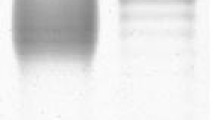Abstract
Sialic acid (N-acetylneuraminic acid, NeuAc) plays an essential role in protecting gram-negative bacteria against the bactericidal activity of serum and may contribute to the pathogenicity of bacteria by mimicking epitopes that resemble host tissue components (molecular mimicry). The role of sialic acid (NeuAc)-containing lipopolysaccharides (LPS) of Salmonella O48 strains in the complement activation of normal human serum (NHS) was investigated. NeuAc-containing lipooligosaccharides cause a downregulation of complement activation and may serve to camouflage the bacterial surface from the immunological response of the host. Serotype O48 Salmonella strains have the O-antigen structure containing NeuAc while its serovars differ in outer membrane protein composition. In this study, the mechanisms of complement activation responsible for killing Salmonella O48 serum-sensitive rods by NHS were established. Four of such mechanisms involving pathways, which are important in the bactericidal mechanism of complement activation, were distinguished: only the classical/lectin pathways, independent activation of the classical/lectin or alternative pathway, parallel activation of the classical/lectin and alternative pathways, and only the alternative pathway important in the bactericidal action of human serum. To further study the role of NeuAc, its content in bacterial cells was determined by gas-liquid chromatography-mass spectrometry in relation to 3-deoxy-D-manno-2-octulosonic acid (Kdo), an inherent constituent of LPS. The results indicate that neither the presence of sialic acid in LPS nor the length of the O-specific part of LPS containing NeuAc plays a decisive role in determining bacterial resistance to the bactericidal activity of complement and that the presence of sialic acid in the structure of LPS is not sufficient to block the activation of the alternative pathway of complement. We observed that for three strains with a very high NeuAc/Kdo ratio the alternative pathways were decisive in the bactericidal action of human serum. The results indicated that those strains are not capable of inhibiting the alternative pathway very effectively. As the pathogenicity of most Salmonella serotypes remains undefined, research into the interactions between these bacterial cells and host organisms is indispensable.




Similar content being viewed by others
References
Bugla-Płoskońska G, Kiersnowski A, Futoma-Kołoch B, Doroszkiewicz W (2009) Killing of gram-negative bacteria with normal human serum and normal bovine serum: use of lysozyme and complement protein in the death of Salmonella strains O48. Microb Ecol 58:276–289
Bugla-Płoskońska G, Doroszkiewicz W (2006) Bactericidal activity of normal bovine serum (NBS) directed against some Enterobacteriaceae with sialic acid-containing lipopolysaccharides (LPS) as a component of cell wall. Pol J Microb 55:169–174
Bugla-Płoskońska G, Cisowska A, Karpińska K, Jankowski S, Doroszkiewicz W (2006) The mechanisms of the activation of normal human serum complement by Escherichia coli strains with K1 surface antigen. Folia Microbiol 51:627–632
Bugla-Płoskońska G, Korzeniowska-Kowal A, Gamian A, Doroszkiewicz W (2004) Bactericidal activity of serum against Salmonella O48 serovars. Int J Antimicrobiol Ag 24:203
Ciurana B, Tomás JM (1987) Role of lipopolysaccharide and complement in susceptibility of Klebsiella pneumoniae to nonimmune serum. Infect Immun 11:2741–2746
Doroszkiewicz W (1997) Mechanism of antigenic variation in Shigella flexneri bacilli. IV. Role lipopolysaccharides and their components in the sensitivity of Shigella flexneri 1b and its Lac + recombinant to killing action of serum. Arch Immunol Ther Exp 45:235–242
Edinger D, Bello E, Mates A (1977) The heterocytotoxicity of human serum. I. Activation of the alternative complement pathway by heterologous target cells. Cell Immunol 29:174–186
Erridge C, Bennett-Guerrero E, Paxton IR (2002) Structure and function of lipopolysaccharides. Microb Infect 4:837–851
Fine DP, Marney SR, Colley DG, Sergent JS, Des Prez RM (1972) C3 shunt activation in human serum chelated with EGTA. J Immunol 109:807–809
Gamian A, Jones C, Lipiński T, Korzeniowska-Kowal A, Ravenscroft N (2000) Structure of the sialic acid-containing O-specific polysaccharide from Salmonella enterica serovar Toucra O48 lipopolysaccharide. Eur J Biochem 267:3160–3167
Gamian A, Kenne L (1993) Analysis of 7-substituted sialic acid in some enterobacterial lipopolysaccharides. J Bacteriol 175:1508–1513
Gamian A, Romanowska A, Romanowska E (1992) Immunochemical studies on sialic acid-containing lipopolysaccharides from enterobacterial species. FEMS Microbiol Immunol 89:323–328
Giammanco GM, Pignato S, Mammina C, Grimont F, Grimont PA, Nastasi A, Giammanco G (2002) Persistent endemicity of Salmonella bongori 48:z35 in Southern Italy: molecular characterization of human, animal and environmental isolates. J Clin Microbiol 9:3502–3505
Grimond PD, Weill FX (2007) Antigenic formulae of the Salmonella serovars, 9th ed.WHO Collaborating Centre for Reference and Research on Salmonella
Holland MCH, Lambris JD (2005) Complement: Encyclopedia of life sciences. Wiley, UK
Joiner KA, Hammer CH, Brown EJ, Cole RJ, Frank MM (1982) Studies on the mechanism of bacterial resistance to complement mediated-killing. I. Terminal complement components are deposited and released from Salmonella Minnesota S218 without causing bacterial death. J Exp Med 155:797–808
Koistinen V (1992) Limited tryptic cleavage of complement factor H abrogates recognition of sialic acid-containing surfaces by the alternative pathway of complement. Biochem J 283:317–319
Meri S, Pangburn MK (1990) Discrimination between activators and nonactivators of the alternative pathway of complement: regulation via a sialic acid/polyanion binding site on factor H. Proc Natl Acad Sci USA 87:3982–3986
Mielnik G, Gamian A, Doroszkiewicz W (2001) Bactericidal activity of normal cord serum (NCS) against Gram-negative rods with sialic acid-containing lipopolysaccharides (LPS). FEMS Immunol Med Microbiol 31:169–173
Moran AP, Prendergast MM, Appelmelk BJ (1996) Molecular mimicry of host structures by bacterial lipopolysaccharides and its contribution to disease. FEMS Immunol Med Microbiol 16:105–115
Odumeru JA, Wiseman GM, Ronald AR (1985) Role of lipopolysaccharide and complement in susceptibility of Haemophilus ducrei to human serum. Infect Immun 50:495–499
Ourth DD, Bachinski LM (1987) Bacterial sialic acid modulates activation of the alternative complement pathway of channel catfish (Ictalurus punctatus). Dev Comp Immunol 11:551–564
Prescott LM, Harley JP, Klein DA (2002) Microbiology, 5th edn. McGraw-Hill, Boston
Ram S, Sharma AK, Simpson SD, Gulati S, Mcquillen DP, Pangburn MK, Rice PA (1998) A novel sialic acid binding site on factor H mediates serum resistance of sialylated Neisseria gonorrhoeae. J Exp Med 187:743–752
Rautemaa R, Meri S (1999) Complement-resistance mechanisms of bacteria. Microb Infect 1:785–794
Ringenberg MA, Steenbergen SM, Vimr ER (2003) The first committed step in the biosynthesis of sialic acid by Escherichia coli K1 does not involve a phosphorylated N-acetylmannosamine intermediate. Mol Microbiol 50:961–975
Rybka J, Gamian A (2006) Determination of endotoxin by the measurement of the acetylated methyl glycoside derivative of Kdo with gas–liquid chromatography-mass spectrometry. J Microbiol Meth 64:171–184
Schmidt BZ, Colten HR (2000) Complement: a critical test of its biological importance. Immunol Rev 178:166–176
Schröter M, Roggentin P, Hofman J, Speicher A, Laufs R, Mack D (2004) Pet snakes as a reservoir for Salmonella enterica subsp. diarizonae (serogroup IIIb): a prospective study. Appl Environ Microb 70:613–615
Selander B, Martensson U, Wientraub A, Holmström E, Matsushita M, Thiel S, Jensenius JC, Truedsson L, Sjöholm AG (2006) Mannan-binding lectin activates C3 and the alternative complement pathway without involvement of C2. J Clin Invest 116:1425–1434
Ślopek S (1970) Immunologia praktyczna. Państwowy Zakład Wydawnictw Lekarskich, Warszawa in Polish
Taylor PW (1983) Bactericidal and bacteriolytic activity of serum against gram-negative bacteria. Microb Rev 1:46–83
Taylor PW, Kroll HP, Tomlinson S (1982) Effect of subinhibitory concentrations of mecillinam on expression of Escherichia coli surface components associated with serum resistance. Drugs Exp Clin Res 8:625–631
Taylor PW, Gaunt H, Unger FM (1981) Effect of subinhibitory concentration of meticillinam on the serum susceptibility of Escherichia coli strains. Antimicrob Ag Chemother 19:786–788
Uzzau S, Brown DJ, Wallis T, Rubino S, Leori G, Bernerd S, Casadesus J, Platt DJ, Olsen JE (2000) Host adapted serotypes of Salmonella enterica. Epidemiol Infect 125:229–255
Waterman SH, Juarez G, Carr SJ, Kilman L (1990) Salmonella ariozona infections in Latinos associated with rattlesnake folk medicine. Am J Pub Health 80:286–289
World Health Organization. Drug-resistant Salmonella. Fact sheet N°139. Revised April 2005
World Health Organization. Food and Agriculture Organization of the United Nations. FAO/WHO Expert Meeting on Salmonella and Campylobacter in chicken meat. FAO Headquarters, Rome, Italy, 4–9 May 2009
Author information
Authors and Affiliations
Corresponding author
Rights and permissions
About this article
Cite this article
Bugla-Płoskońska, G., Rybka, J., Futoma-Kołoch, B. et al. Sialic Acid-Containing Lipopolysaccharides of Salmonella O48 Strains—Potential Role in Camouflage and Susceptibility to the Bactericidal Effect of Normal Human Serum. Microb Ecol 59, 601–613 (2010). https://doi.org/10.1007/s00248-009-9600-2
Received:
Accepted:
Published:
Issue Date:
DOI: https://doi.org/10.1007/s00248-009-9600-2




